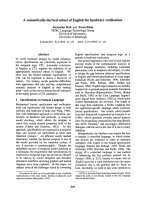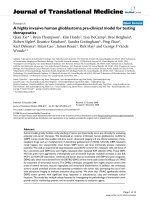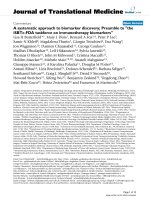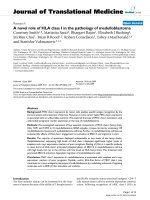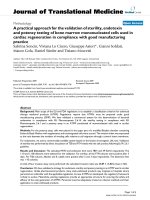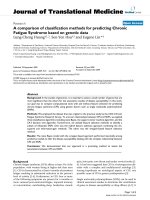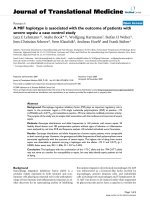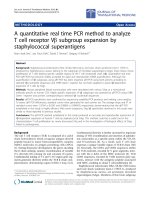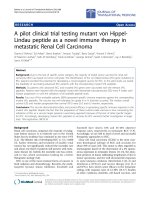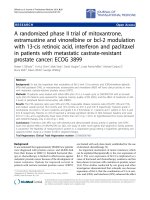Báo cáo hóa học: " A truly green synthesis of a-aminonitriles via Strecker reaction" pdf
Bạn đang xem bản rút gọn của tài liệu. Xem và tải ngay bản đầy đủ của tài liệu tại đây (863.44 KB, 5 trang )
ORIGINAL Open Access
A truly green synthesis of a-aminonitriles via
Strecker reaction
Debasish Bandyopadhyay, Juliana M Velazquez and Bimal K Banik
*
Abstract
Background: The classical Strecker reaction is one of the simplest and most economical methods for the synthesis
of racemic a-aminonitriles (precursor of a-amino acids) and pharmac ologically useful compo unds.
Results: Indium powder in water is shown to act as a very efficient catalyst for one-pot, three-component
synthesis of a-aminonitriles from diverse amines, aldehydes and TMSCN. This general rapid method is applicable to
a wide range of amines and aldehydes and produces products in excellent yield.
Conclusions: The present one-pot, three-component environmentally benign procedure for the synthesis of a-
aminonitriles will find application in the synthesis of complex biologically active molecules.
Background
Strecker reaction [1], the oldest known synthesis of a-
aminonitriles, is one of the most general methods
potentially useful for syntheses of amino acids and other
bioactive compounds including natural products. In
addition, the Strecker reaction represents one of the
simplest and most economical methods for the prepara-
tion of a-amino acids for both labor atory and industrial
scales [2]. Since 1850, a number of publications have
appeared on this reaction. Still this reaction is under
active investigation. Recently, synthesis of hepatitis C
virus NS3 serine protease inhibitors [3], (±)-phthalasci-
din 622 [4] and novel boron-containing retinoids [5]
have been reported following this strategy. A number of
new catalysts have also been reported for this reaction
which includes mesoporous aluminosilicate (Al-MCM-
41) [6], lanthanum(III)-binaphthyl disulfonate [7], nano-
crystalline magnesium oxide [8], BINOL-phosphoric
acid [9,10 ], Fe(C p)
2
PF
6
[11], Jacobsen’s thiourea catalyst
[12], N-heterocyclic carbene (NHC)-amidate palladium
(II) complex [13], Yb(OTf)
3
-pybox [14], K
2
PdCl
4
[15],
gallium (III) triflate [16], bisformamides [17], IBX/TBAB
[18], Lewis base e. g. N,N-dimethylcyclohexylam ine [19],
superparamagnetic iron oxide [20], and ionic liquid [21].
To prepare a-aminonitriles (precursor to a-amino
acids) generally an imine is reacted with a cyanide
source. Notable among them are HCN [22], KCN [23],
(EtO)
2
P(O)CN [24,25], Et
2
AlCN [26,27], Bu
3
SnCN
[28,29], and TMSCN [3,4,6-20]. Among these cyanide
sources, trimethylsilyl cyanide (TMSCN) is relatively
easy to handle and highly soluble in organic solvents. In
contrast, many of these reported methods involve the
use of expensive reagents, hazardous solvents, longer
reaction times and tedious workup procedure. There-
fore, it is desirable to develop an efficient and practical
method for the Strecker reaction under eco-friendly
conditions.
Results
We have been working on the synthesis and biological
evaluation of various b-lactams as novel anticancer
agents [30-35] over the past several years. The sy nthesis
of b-lactams through imines requires a carbonyl com-
pound and an amine. Our study suggests that carbonyl
compounds, amines and TMSCN in the presence of a
mild acidic reagent will lead to the synthesis of a-ami-
nonitriles in good to excellent yield. This hypothesis has
been tested by reacting several amines with various car-
bonyl compounds and TMSCN in the presence of
indium as catalyst. Recently, organic reactions i n water
have received much attention in view of green meth-
odologies [36]. First of all, indium and a number of
indium salts have been screened using aniline, benzalde-
hyde and TMSCN as a model reaction at room tem-
perature. The results are shown in Tab le 1. The
* Correspondence:
Department of Chemistry, The University of Texas-Pan American, 1201, West
University Drive, Edinburg, TX 78539, USA
Bandyopadhyay et al. Organic and Medicinal Chemistry Letters 2011, 1:11
/>© 2011 Bandyopadhya y et al; licensee Springer. This is an Open Access article dist ributed under the terms o f the Creativ e Commons
Attribution License (http://creativecom mons.org/licenses/by/2.0), which permits unrestricted use, distribu tion, and reproduction in
any medium, provided the original work is properly cited.
reaction was then performed in various solvents using
indium as the catalyst to identify the best condition. It
suggests that indium is the best catalyst in aqueous med-
ium for the reaction (Table 2). The s ame reaction was
used to optimize the amount of the catalyst. The results
show (T able 3) that 10 mol% indium is required to com-
plete the reaction in 30 minutes. Considering the above
observations we carried out a series of reaction using var-
ious carbonyl compounds, amines and TMSCN in p re-
sence of indium (10 mol%) in water as solvent (Figure 1).
In all t he cases, the reactions were completed within 30
min to 1.5 hr and the products were obtained in excellent
yield (Table 4). The products have demonstrated satisfac-
tory spectral and mp data with the reported values.
Discussion
Aseriesofa-aminonitriles were synthesized by using
diverse amines, aldehydes and TMSCN in the presence
of indium metal (10 mol%) as catalyst in water. As
shown in Table 4, the reaction proceeded equally well
irrespective of the nature of the carbonyl compounds
(aliphatic, aromatic, heteroaromatic) or amines (alipha-
tic, heterocyclic, and aromatic) to afford the
corresponding products in excellent yield (79-98%). The
catalytic system worked well with acid sensitive hetero-
aromatic aldehyde (entries 4, 6, 7), a, b unsaturated
aldehyde (entry 3), aliphatic aldehyde (entry 5) and
ketone (entry 10). Aromatic primary amine (aniline),
benzyl amine (entry 6), heterocyclic amines (entries 7, 8
and 9) could e ffectiv ely undergo Strecker reaction with
aldehydes and TMSCN to give the corresponding pro-
ducts in excellent yields (94-97%). For aliphatic amines
such as benzyl amine, piperidine and morpholine rela-
tively slower reaction rate was observed.
A plausible mechanism may follow a two-step path-
way. In the first step, indium acts as an Lewis acid to
facilitate formation of the corresponding imine from the
condensation of the amine and aldehyde. In the subse-
quent step, the imine is further activated due to the pre-
senceofindium,toformamoreelectrophilicC=N
intermediate. As a result, an attack of TMSCN to the
imine carbon can take place and thus the corresponding
a-aminonitriles is formed via hydrolysis in water.
Conclusions
There is growing interest in the one-pot Strecker synthesis
of a-aminonitriles from carbonyl compounds, amines and
TMSCN, because of the significant importance of a-amino-
nitriles in preparing a wide variety of amino acids, amides,
diamines, and nitrogen containing heterocycles. In sum-
mary, we have developed a rapid, convenient and efficient
one-pot, three- component environmentally benign Strecker
reaction using indium as catalyst at room temperature. A
series of a-aminonitriles were obtained in excellent yields.
This reaction will be applicable to the synthesis of various
organic compounds of medicinal interests.
Methods
General
FT-IR spectra were registered on a Bruker IFS 55 Equi-
nox FTIR spectrophotometer as KBr discs.
1
H-NMR
Table 1 Three component Strecker reaction using aniline
(1 mmol), benzaldehyde (1 mmol) and TMSCN (1.2 mmol)
in water (30 min): catalyst optimization
Entry Catalyst
(10 mol %)
Yield (%)
a
1 Indium 98
2 Indium (II) chloride 70
3 Indium (III) chloride 82
4 Indium (III) bromide 85
5 Indium selenide 62
6 Indium oxide 48
a
isolated yield
Table 2 Three component Strecker reaction using aniline
(1 mmol), benzaldehyde (1 mmol) and TMSCN (1.2 mmol)
in presence of indium (10 mol%) in various solvents (30
min): solvent optimization
Entry Solvent Yield (%)
a
1 Water 98
2 THF 34
3 Ethanol 56
4 Toluene 60
5 Methanol 68
6 Dichloromethane 61
7 DMSO 76
8 THF/H
2
O (1:1) 54
9 Ethanol/H
2
O (1:1) 71
a
isolated yield
Table 3 Three component Strecker reaction using aniline
(1 mmol), benzaldehyde (1 mmol) and TMSCN (1.2 mmol)
in water (30 min): optimization of the amount of the
catalyst
Entry Indium (mol %) Yield (%)
a
130 89
225 91
320 88
415 89
510 98
65 67
72 54
81 43
a
isolated yield
Bandyopadhyay et al. Organic and Medicinal Chemistry Letters 2011, 1:11
/>Page 2 of 5
Figure 1 Three component Strecker reaction using amines (1 mmol), carbonyl compounds (1 mmol) and TMSCN (1.2 mmol) in water
in presence of indium (10 mol%).
Table 4 Three component Strecker reaction using amines (1 mmol), carbonyl compounds (1 mmol) and TMSCN (1.2
mmol) in water in presence of indium (10 mol%)
Entry Amine Carbonyl compound Product Time (min) Yield (%)
a
Ref.
1
30 98 [11]
2
75 93 [15]
3
75 79 [11]
4
45 86 [11]
5
60 88 [11]
6
75 91 [11]
7
90 94 [21]
8
75 95 [21]
Bandyopadhyay et al. Organic and Medicinal Chemistry Letters 2011, 1:11
/>Page 3 of 5
(600 MHz) and
13
C-NMR (125 MHz) spectra were
obtained at room temperature with Bruker-600 equip-
ment using TMS as internal standard and CDCl
3
as sol-
vent. Analytical grade chemicals (Sigma-Aldrich
Corporation) were use d throughout the project. Deio-
nized water was used for the preparation of all aqueous
solutions.
General procedure for the one-pot, three-component
Strecker reaction
A representative experimental procedure (entry 1) is as
follows: In po wder (11 mg) was added to a mixture of
aniline (1 mmol), benzaldehyde (1 mmol) and TMSCN
(1.2 mmol) in water (1 mL). The resulting mixture was
stirred at room temperature and the progress of the
reaction was monitored by TLC. After completion of
the reaction (Table 4) diethyl ether w as added and the
solution was f iltered, washed with brine and water. It
was dried over anhydrous sodium sulphate and filtered.
A short column of silica gel was used to purify the pro-
duct 2-phenyl-2-(phenylamino)-acetonitrile in 98% yield.
Acknowledgements
We gratefully acknowledge the funding support from National Cancer
Institute (NIH/NCI-P20, Grant# 5P20CA138022-02).
Competing interests
The authors declare that they have no competing interests.
Received: 22 March 2011 Accepted: 4 October 2011
Published: 4 October 2011
References
1. Strecker A (1850) Ueber die künstliche Bildung der Milchsäure und einen
neuen, dem glycocoll homologen. Ann Chem Pharm 75:27–45. doi:10.1002/
jlac.18500750103.
2. Gröger H (2003) Catalytic enantioselective Strecker reactions and analogous
syntheses. Chem Rev 103:2795–2827. doi:10.1021/cr020038p.
3. Arasappan A, Venkatraman S, Padilla AI, Wu W, Meng T, Jin Y, Wong J,
Prongay A, Girijavallabhan V, Njoroge GF (2007) Practical and efficient
method for amino acid derivatives containing β-quaternary center:
application toward synthesis of hepatitis C virus NS3 serine protease
inhibitors. Tetrahedron Lett 48:6343–6347. doi:10.1016/j.tetlet.2007.07.002.
4. Razafindrabe CR, Aubry S, Bourdon B, Andriantsiferana M, Pellet-Rostaing S,
Lemaire M (2010) Synthesis of (±)-phthalascidin 650 analogue: new
synthetic route to (±)-phthalascidin 622. Tetrahedron 66:9061–9066.
doi:10.1016/j.tet.2010.08.053.
5. Das BC, Anguiano J, Mahalingam SM (2009) Design and synthesis of α-
aminonitrile-functionalized novel retinoids. Tetrahedron Lett 50:5670–5672.
doi:10.1016/j.tetlet.2009.07.119.
6. Iwanami K, Seo H, Choi J-C, Sakakura T, Yasuda H (2010) Al-MCM-41
catalyzed three-component Strecker-type synthesis of α-aminonitriles.
Tetrahedron 66:1898–1901. doi:10.1016/j.tet.2010.01.001.
7. Hatano M, Hattori Y, Furuya Y, Ishihara K (2009) Chiral lanthanum(III)-
binaphthyldisulfonate complexes for catalytic enantioselective Strecker
reaction. Org Lett 11:2321–2324. doi:10.1021/ol900680f.
8. Kantam ML, Mahendar K, Sreedhar B, Choudary BM (2008) Synthesis of α-
amino nitriles through Strecker reaction of aldimines and ketoimines by
using nanocrystalline magnesium oxide. Tetrahedron 64:3351–3360.
doi:10.1016/j.tet.2008.01.128.
9. Simo’n L, Goodman JM (2009) Mechanism of BINOL-phosphoric acid-
catalyzed Strecker beaction of benzyl imines. J Am Chem Soc
131:4070–4077. doi:10.1021/ja808715j.
10. Zhang G-W, Zheng D-H, Nie J, Wang T, Ma J-A (2010) Bronsted acid-
catalyzed efficient Strecker reaction of ketones, amines and trimethylsilyl
cyanide. Org Biomol Chem 8:1399–1405. doi:10.1039/b924272d.
11. Khan NH, Agrawal S, Kureshy R, Abdi SHR, Singh S, Suresh E, Jasra RV (2008)
Fe(Cp)
2
PF
6
catalyzed efficient Strecker reactions of ketones and aldehydes
under solvent-free conditions. Tetrahedron Lett 49:640–644. doi:10.1016/j.
tetlet.2007.11.136.
12. Pan SC, List B (2007) Catalytic asymmetric three-component acyl-Strecker
reaction. Org Lett 9:1149–1151. doi:10.1021/ol0702674.
13. Jarusiewicz J, Choe Y, Yoo K, Park CP, Jung KW (2009) Efficient three-
component Strecker reaction of aldehydes/ketones via NHC-amidate
palladium(II) complex catalysis. J Org Chem 74:2873–2876. doi:10.1021/
jo900163w.
14. Karimi B, Maleki A, Elhamifar D, Clark JH, Hunt AJ (2010) Self-assembled
organic-inorganic hybrid silica with ionic liquid framework: a novel support
for the catalytic enantioselective Strecker reaction of imines using Yb(OTf)3-
pybox catalyst. Chem Commun 46:6947–6949. doi:10.1039/c0cc01426e.
15. Karmakar B, Banerji J (2010) K
2
PdCl
4
catalyzed efficient multicomponent
synthesis of α-aminonitriles in aqueous media. Tetrahedron Lett
51:2748–2750. doi:10.1016/j.tetlet.2010.03.059.
16. Prakash GKS, Mathew T, Panja C, Alconcel S, Vaghoo H, Do C, Olah GA
(2007) Gallium (III) triflate catalyzed efficient Strecker reaction of ketones
and their fluorinated analogs. Proc Nat Acad Sci USA 104:3703–3706.
doi:10.1073/pnas.0611316104.
17. Wen Y, Xiong Y, Chang L, Huang J, Liu X, Feng X (2007) Chiral
bisformamides as effective organocatalysts for the asymmetric one-pot,
three-component Strecker reaction. J Org Chem 72:7715–7719. doi:10.1021/
jo701307f.
18. Fontaine P, Chiaroni A, Masson G, Zhu J (2008) One-pot three-component
synthesis of α-iminonitriles by IBX/TBAB-mediated oxidative Strecker
reaction. Org Lett 10:1509–1512. doi:10.1021/ol800199b.
19. Cruz-Acosta F, Santos-Exposito A, de Armas P, Garcia-Tellado F (2009) Lewis
base-catalyzed three-component Strecker reaction on water. An efficient
manifold for the direct α-cyanoamination of ketones and aldehydes. Chem
Commun 44:6839–6841
Table 4 Three component Strecker reaction using amines (1 mmol), carbonyl compounds (1 mmol) and TMSCN (1.2
mmol) in water in presence of indium (10 mol%) (Continued)
9 90 97 [21]
10
45 98 [10]
a
isolated yield
Bandyopadhyay et al. Organic and Medicinal Chemistry Letters 2011, 1:11
/>Page 4 of 5
20. Mojtahedi MM, Saeed AM, Alishiri T (2009) Superparamagnetic iron oxide as
an efficient catalyst for the one-pot, solvent-free synthesis of α-
aminonitriles. Tetrahedron Lett 50:2322–2325. doi:10.1016/j.
tetlet.2009.02.199.
21. Mojtahedi MM, Abaee MS, Abbasi H (2006) Environmentally friendly room
temperature strecker reaction: one-pot synthesis of α-aminonitriles in ionic
liquid. J Iran Chem Soc 3:93–97
22. Kato N, Suzuki M, Kanai M, Shibasaki M (2004) Catalytic enantioselective
Strecker reaction of ketimines using catalytic amount of TMSCN and
stoichiometric amount of HCN. Tetrahedron Lett 45:3153–3155. doi:10.1016/
j.tetlet.2004.02.077.
23. Gruszecka E, Soroka M, Mastalerz P (1979) Preparation of D,L-
phosphinothricin by Strecker reaction. Polish J Chem 53:937–9
24. Reimann E, Dammertz W (1983) Bicyclic α-amino acids. IV: Synthesis of 3-(1-
tetralinyl)- and 3-(5,6,7,8-tetrahydro-5-quinolinyl)alanine. Arch Pharm
316:297–302. doi:10.1002/ardp.19833160403.
25. Harusawa S, Hamada Y, Shioiri T (1979) New methods and reagents in
organic synthesis. 5. Diethyl phosphorocyanidate (DEPC). A novel reagent
for the classical Strecker’s α-amino nitrile synthesis. Tetrahedron Lett
48:4663–4666
26. Davis FA, Prasad KR, Carroll PJ (2002) Asymmetric synthesis of polyhydroxy
α-amino acids with the sulfinimine-mediated asymmetric Strecker reaction:
2-amino 2-deoxy L-xylono-1,5-lactone (Polyoxamic acid lactone). J Org
Chem 67:7802–7806. doi:10.1021/jo020302e.
27. Kaur P, Pindi S, Wever W, Rajale T, Li G-G (2010) Asymmetric catalytic
Strecker reaction of N-phosphonyl imines with Et
2
AlCN using amino
alcohols and BINOLs as catalysts. Chem Commun 46:4330–4332.
doi:10.1039/c0cc00287a.
28. Xie Z, Li G, Zhao G, Wang J (2009) Strecker-type reaction catalyzed by
carboxylic acids in aqueous media. Synthesis 12:2035–2039
29. Ishitani H, Komiyama S, Hasegawa Y, Kobayashi S (2000) Catalytic
asymmetric Strecker synthesis. Preparation of enantiomerically pure α-
amino acid derivatives from aldimines and tributyltin cyanide or achiral
aldehydes, amines, and hydrogen cyanide using a chiral zirconium catalyst.
J Am Chem Soc 122:762–766. doi:10.1021/ja9935207.
30. Becker FF, Banik BK (1998) Polycyclic aromatic compounds as anticancer
agents: synthesis and biological evaluation of some chrysene derivatives.
Bioorg Med Chem Lett 8:2877–2880
31. Becker FF, Mukhopadhyay C, Hackfeld L, Banik I, Banik BK (2000) Polycyclic
aromatic compounds as anticancer agents: synthesis and biological
evaluation of dibenzofluorene derivatives. Bioorg Med Chem 8:2693–2699
32. Banik BK, Becker FF (2001) Polycyclic aromatic compounds as anticancer
agents. 4. Structure-activity relationships of chrysene and pyrene derivatives.
Bioorg Med Chem 9:593–605. doi:10.1016/S0968-0896(00)00297-2.
33. Banik BK, Becker FF (2001) Synthesis, electrophilic substitution and
structure-activity relationship studies of polycyclic aromatic compounds
towards the development of anticancer agents. Curr Med Chem
8:1513–1533
34. Banik BK, Becker FF, Banik I (2004) Synthesis of anticancer β-lactams:
Mechanism of action. Bioorg Med Chem 12:2523–2528
35. Banik I, Becker FF, Banik BK (2003) Stereoselective Synthesis of β-Lactams
with Polyaromatic Imines: Entry to New and Novel Anticancer Agents. J
Med Chem 46:12–15
36. Li C-J (2005) Organic reactions in aqueous media with a focus on carbon-
carbon bond formations. A decade update. Chem Rev 105:3095–3165.
doi:10.1021/cr030009u.
doi:10.1186/2191-2858-1-11
Cite this article as: Bandyopadhyay et al.: A truly green synthesis of a-
aminonitriles via Strecker reaction. Organic and Medicinal Chemistry Letters
2011 1:11.
Submit your manuscript to a
journal and benefi t from:
7 Convenient online submission
7 Rigorous peer review
7 Immediate publication on acceptance
7 Open access: articles freely available online
7 High visibility within the fi eld
7 Retaining the copyright to your article
Submit your next manuscript at 7 springeropen.com
Bandyopadhyay et al. Organic and Medicinal Chemistry Letters 2011, 1:11
/>Page 5 of 5
